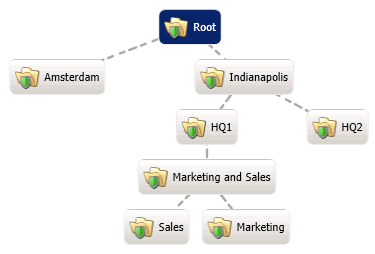- Contents
Interaction Administrator Help
Access control groups
Access control groups (ACGs) provide a flexible way of defining administrative access rights. With ACGs, it becomes simple to make someone the administrator of a department or location. The administrator can then create users, stations, and other objects related to the department or location, without being able to access objects that are outside of that department or group. A full list of all the objects supported by ACGs appears later in this section. For example, an ACG can allow an administrator access to manage and modify users and workgroups within a certain part of the organization, without having access to other parts of the organization.
Hierarchical Structure of Access Control Groups
An ACG is similar to Active Directory structure, where the structure is a hierarchical arrangement of information about objects. The ACG allows access rights to be assigned against the hierarchy to define which objects or items (see item list below) a user can access. You can define multiple ACGs containing subsets of objects from the "root" ACG. A user can have access to one ACG or multiple ACGs.
With the hierarchy in place, an organization can give administrative rights to each of the ACGs. A user who gets administrative permission for East Region – Marketing can only see users, workgroups, and other objects for that ACG. The user won’t be able to see or modify any of the objects in the other ACGs. An administrator who has permissions for East Region will have access to all objects that in that ACG and its child ACGs: East Region – Marketing and East Region – Support. An administrator who has permissions for an ACG automation inherits security rights for child ACGs. The following object types support ACGs: · Users · Roles · Workgroups · Skills · Stations, station groups, and station templates · IP phones, proxy groups, ring sets, and templates · Wrap-up codes and categories · Account codes · Schedules · Client configuration templates · Password policies · Locations · Analyzer keyword sets
CIC includes a default ACG "Root," which is the parent of the hierarchy.

To create levels in the hierarchy, first create ACGs from the root. Then create a second level of ACGs from, and so on. The maximum levels in a hierarchy is five (5). For example:

An ACG can have only a single parent, and an item can only be a member of a one ACG.
ACGs can contain the following items:
Related topics
Access control groups: members
Access control groups: members field descriptions
Access control groups: advanced
Access control groups: advanced field descriptions



